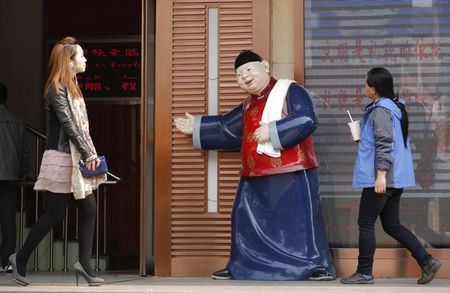By Kevin Yao and Xiaoyi Shao
BEIJING (Reuters) - China's economy lost further momentum heading into the fourth quarter as a cooling property market weighed on activity and export demand softened, surveys showed on Monday, putting Beijing's official target for the year at even greater risk.
Analysts had already expected full-year growth to miss the goal of around 7.5 percent, but many thought there may be some signs of stabilisation in the world's second-largest economy late in the year after a flurry of stimulus measures.
Instead, the surveys showed demand at home and abroad continued to cool and the labour market remained under stress, while adding to fears that many companies are being starved of credit as banks grow more reluctant to lend.
And measures announced in late September to shore up the slumping housing market so far seem to be having little effect, reinforcing expectations that Beijing will have to stump up more support.
"Growth momentum is slowing going into the fourth quarter," said Kevin Lai, senior economist at Daiwa Capital Markets in Hong Kong.
"Exports were quite strong the last couple of months but that was mostly driven by electronics demand. So the orders for iPhones etc. have cooled down again. Europe and Japan are still struggling, so that is not good news."
Growth in China's services sector slipped to a nine-month low of 53.8 in October, the weakest reading since January, from September's 54.0, the National Bureau of Statistics said.
It was still comfortably above the 50-point mark that separates growth from contraction, but readings on areas such as real estate and employment continued to shrink.
Home prices in China dropped for a sixth consecutive month in October, a separate private survey showed on Friday, pointing to a persistent downturn, despite government efforts to lift the market.
Beijing is counting on strong job growth in the services sector to offset that weakness, and top policymakers have insisted that the labour market remains resilient.
FACTORY GROWTH ALSO FRAGILE
Another official survey on Saturday showed factory activity unexpectedly fell to a five-month low in October as firms fought slowing orders and rising borrowing costs.
A private factory survey by HSBC/Markit on Monday showed a similar worrying trend. Though overall growth picked up slightly, growth in new orders and new export orders - proxies for domestic and foreign demand - fell to their lowest in four to five months.
Exports have been one of the lone bright spots for the economy, and helped offset weaker internal demand in the third quarter.
Tommy Xie, an economist at OCBC Bank, estimated that without firmer exports, the economy would only grow an annual 6.7 percent in the first three quarters this year - the slowest since the 1998 Asian crisis.
The official PMI is focussed on larger, state-owned factories, as opposed to the HSBC/Markit PMI which focuses more on smaller manufacturers in the private sector.
MORE SUPPORT MEASURES
Most analysts believe authorities will announce further modest support measures in coming months to support growth, but they are divided over whether policymakers will act more aggressively, such as by cutting interest rates, unless there is a risk of a sharper slowdown.
Barclays expects a bolder policy response soon.
"We maintain our forecast for two, 25-basis-point cuts in benchmark interest rates, one in Q4 14 and one in Q1 15," the bank's economists said in a research note.
"Weakening October official PMI, soft domestic demand and rising disinflationary risks are adding to the probability of more monetary easing. We also note that the PMI shows that the targeted easing measures are not effective in supporting small- to medium-size enterprises."
China's annual economic growth slowed to 7.3 percent in the third quarter, the weakest pace since the global financial crisis, even as the government rolled out more stimulus measures.
A Reuters poll published last month forecast the economy could grow at an annual 7.3 percent in the fourth quarter, leaving the full-year pace at 7.4 percent - the weakest in 24 years.
But Daiwa's Lai was more bearish, expecting fourth-quarter growth to slow to 6.9 percent, dragging full-year growth to 7.2 percent.
FUNDING COSTS RISING
The government has vowed to maintain policy measures which are targeted at the most vulnerable sectors of the economy.
So far this year, it has accelerated construction of railway and public housing projects, cut reserve requirements (RRR) for some banks and, perhaps most significantly, loosened lending rules to support the housing market.
As would be expected, the official factor survey on Saturday showed big Chinese factories were weathering the downturn better than their smaller counterparts, as banks prefer to lend to larger state-owned firms, assuming the government will bail them out to prevent any defaults.
But Chinese companies in general are facing higher borrowing costs as banks grow more cautious about the cooling economy.
Funding costs rose 13.5 percent in the first nine months of this year compared with a year ago, the government survey showed, adding to the burden on factories which are already battling shrinking profit margins.
China's biggest banks last week reported rising bad loans for the third quarter, and one said the credit crunch which is squeezing small companies in the country's export-oriented eastern provinces may be spreading westwards.

"The possibility that risks will gradually spread from small enterprises to large and medium enterprises ... and from eastern region and coastal areas of China to central and western regions will be intensified," the country's fifth-largest listed lender Bank of Communications Co Ltd (SS:601328) (HK:3328) said.
(Additioanl reporting by Koh Gui Qing and Jake Spring; Editing by Kim Coghill)
